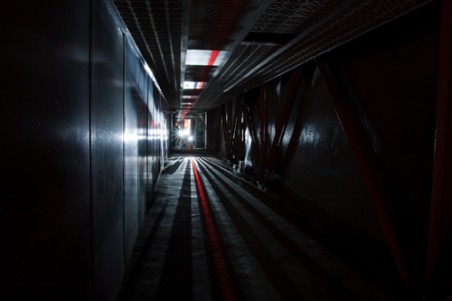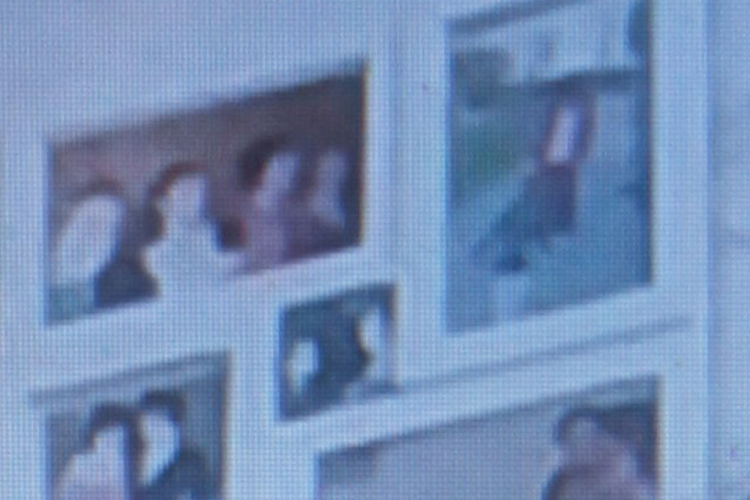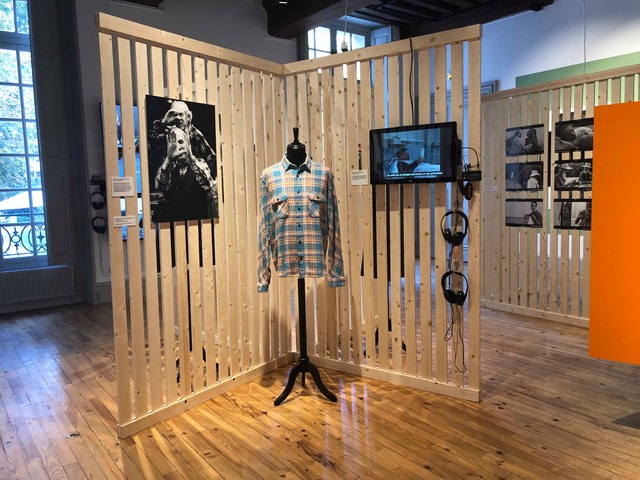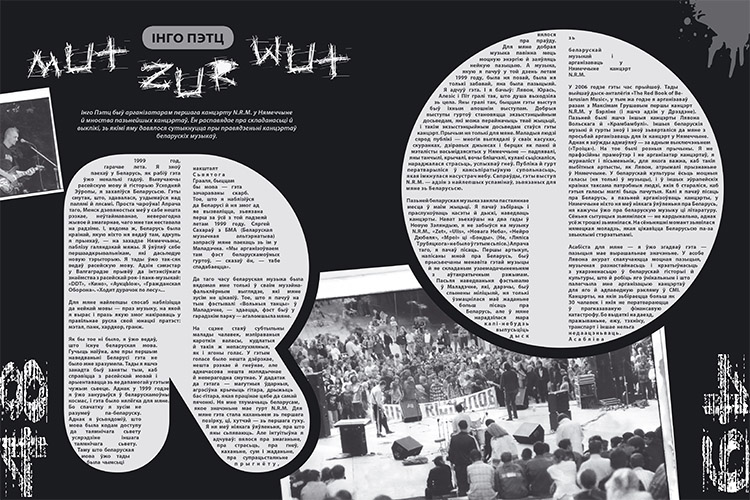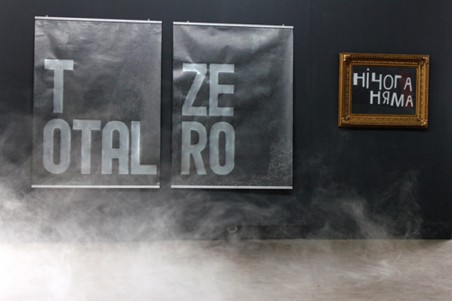
Alaksiej Łuniou, Total Zero
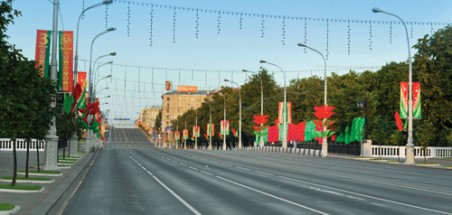
Uładzimir Cesler, Minsk City
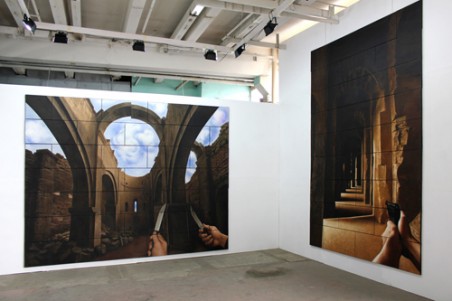
Rusłan Vaśkiević, Hunting of Minotaur
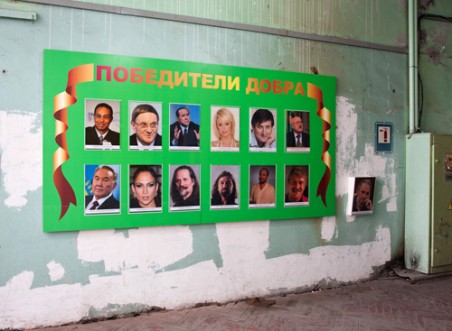
Michaił Hulin, Good’s Victors
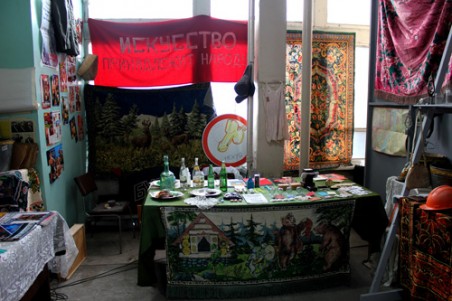
Artur Klinau, Partisan’s Boutique transportable
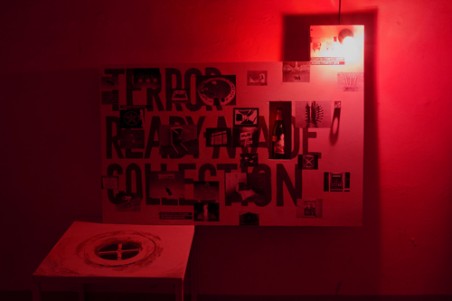
Siarhiej Śabochin, Subordination Practices
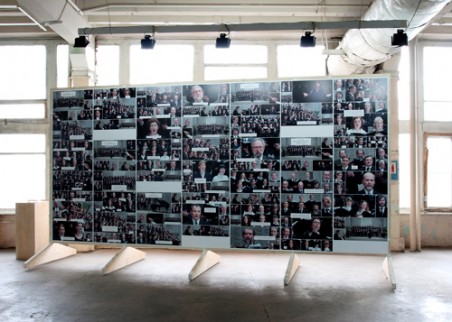
Maksim Tymińka, Five Songs about Physiks
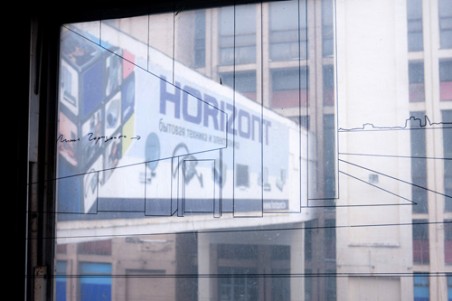
Ihar Saućanka, Sun’s Light penetrating through the window
© Published in pARTisan #19’2012
The curators of the research project Zero Radius. Art of the 00’s Onthology, an artist Rusłan Vaśkiević, a curator Aksana Źhirouskaja and a philosopher Volha Śparaha organised the same title exhibition. It was held in the abandoned premises of Horizont plant in Minsk. Fifteen Belarusian artists were selected to participate in it. Their works, according to experts, have become iconic ‘art of the Belarusian 00’s’.They are as follows: Revision group (Andrej Durejka, Źana Hrak, Andrej Łoginau, Maksim Vakulćyk), Rusłan Vaśkiević, Michaił Hulin, Siarhiej Źdanović, Alaksej Ivanou, Siarhiej Kiruśćanka, Artur Klinau, Alaksiej Łuniou, Andrej Lankiević, Maryna Napruśkina, Arciom Rybćynski, Ihar Saućanka, Maksim Tymińka, Uładzimir Cesler, Siarhiej Śabochin.
Did it go the way it had been planned? How objective was the presentation of the art of the 00’s? Will the exhibition have a further continuation? pARTisan is talking with the project’s curators.
Both the experts and the audience expressed a lot of criticism alongside with positive reviews. How do you personally assess the results?
Rusłan Vaśkiević: I think we managed to do our job pretty well. A certain number of failures actually contributed to it. For example, we were not able to find premises for the exhibition at the official platforms. In one place we didn’t fit the plan, in the other one we were refused for ideological reasons. But in the end, the premises, which we had managed to find, an abandoned factory floor at Horizont plant, became a huge advantage for the exhibition.
Aksana Źhirouskaja: My expectations were also fully met. What really impressed me was the number of visitors: about five thousand people within a ten day-period is quite a lot for Minsk. We see our mistakes very clearly, we realize that some things could have been done better. But three curators were obviously not enough for such a big project. To have done everything in the best way possible, we would have needed at least six people involved.
R.V.: We also desperately lack more experience, which is necessary for arranging such kind of events.
Volha Śparaha: Those who were criticising us gave us, to my mind, a clear and important message: the exhibition turned out to be a project within another project. In fact, the concept of studying urban space based on the example of Minsk can not be automatically derived from the notion of ‘art of the 00’s’. The thing is that we didn’t clearly state a transition from our big project ‘Art of the 00’s Onthology’ to the concept of the exhibition itself.
R.V.: Although the title of the exhibition was spelled with a dot: ‘Minsk — Zero Radius. Art of the 00’s Onthology’.
V.Ś.: But that was not enough. For instance, it was not quite clear how the works of those artists who live abroad and don’t specifically work with the Belarusian theme are connected with Minsk. When we were asked such a controversial question, we responded that the key notion for us was the idea of space. But in our booklets it was written ‘Miensk. We obviously didn’t work out such conceptual aspects properly. Another drawback was, to my mind, the titles of the objects of art; they should have also been wider. For some of them, for example, Alaksej Ivanou’s and Rusłan Vaśkiević’s works, there were no explications at all. It diminished the importance of the exhibition in a way. Some of the audience came to such kind of show for the first time in their lives, others were rare visitors to the exhibitions of contemporary art. Therefore they did not understand much. As for the lecture-discussion part, which I supervised, I think our strong point was that the lecturers were very well prepared: they were telling things that hadn’t been said anywhere before. Also, they were making a good use of visuals.
You’ve said that you reached your goals and fulfilled the tasks which had been set. What kind of tasks were they? In the annotation to the exhibition a lot of goals are mentioned; maybe that was the reason for the misunderstanding and controversial questions.
R.V.: Initially, we had several options of visual arrangement of the exhibition. For example, in the form of a chronicles. But then we decided to arrange a fully independent exhibition which would be of great interest for both general public and artists, who are not spoilt by high quality exhibitions. Many of the artists who took part in it don’t have a possibility to display their works at big platforms; they are just not let there for various unjustified reasons. At the same time, experts say that these authors are the ones who have become indicative in the last decade.
Many artists shared our curators’ opinion as soon as they came into the display hall and saw this potentially new dimension, discovered by us and for us. Some of the artists created completely new works to fit this particular space. The theme of Minsk organically emerged in the title of the exhibition after we had got this new ‘territory’. It looked as if we were invading a new urban space. In terms of authors’ presentations, I personally viewed the whole scene of the exhibition as a complete thing, and I guess it worked that way.
The emphasis was placed not on studying Minsk as an urban space but, namely, on the artists’ fascination with new territory, wasn’t it?
R.V.: It was new for Minsk. It’s already become a tendency in the world. The time has come to ‘occupy’ official territories, museums, the city itself, by big boards, announcement posts, whatever. The ‘occupation’ of the city space should be fulfilled with the help of contemporary art! It inspires! Street art and public art also contribute to it. It’s weird to lock oneself in a gallery and work with the chronicles of the decade, realising at the same time that the world outside is changing every day. It’s not an “archive” of the people of yesterday; it’s a natural reaction of modern artists who are faced with new tasks nowadays.
Does it mean that the key points were space and artists? Not the works themselves, but a complex message that can be combined from particular works. And the artists whose works fit the given space?
A.Źh.: It was also essential for us that the artists had a chance to express their points of view on space from different perspectives.
R.V.: It’s clear that the list of artists was quite predictable as well as their personal presentations. But a new condition, the condition of space obliged both the painter and the viewer to select new forms of expression. When we were discussing the theme of the exhibition, when we began to analyse what people and events as well as what art projects the experts had chosen, we noticed that almost all the artists had been working with the theme of space in the last decade. Śabochin shows a personal and public space, Napruśkina is working in the field of social space. Klinau’s Boutique is also a spatial thing: it’s transportable, he takes it to various places; it’s a space in a narrow-minded sense. Another example is Revision group, who ‘stole’ the museum space and went into a new dimension. It’s a pity that we didn’t state it in the explication of the exhibition.
One of the critical reviews voiced an opinion that the artists brought to the exhibition their ‘yesterday and the day before yesterday’…
V.Ś.: I wouldn’t agree with the opinion that the exhibition is just a ‘thing of the past’. It displayed a number of completely new works, for example, works of Śabochin, Lankiević, Gulin. It’s strange that the public didn’t notice the difference between old and new trends. It is true that Klinau’s Boutique had been displayed and seen many times (it’s worth mentioning, though, that it’s a thing of the 00’s; he first presented it in 2003). But the exhibition was not fully placed in his Boutique.
It started with the Boutique and ended with works of Śabochin. This, in my opinion, is a very interesting path: from the irony of guerrilla art in modern conditions to an art-activist position. It is strang to see here not the path, but the same thing. Maybe our public were expecting to see some major breakthroughs? Although, Śabochin does such kind of things which are already quite a new language, it’s a new way of perceiving social reality, personal and political contexts. It’s a reaction to what is happening in our country and can’t leave the artist indifferent. Of course, these are not positive emotions. And if the ‘terrorists don’t make demands’, as some article says, then it only explained by the conditions which exist in our country. But we didn’t have ‘terrorist’ before, we had only ‘partisans’.
When you called you exhibition ‘Zero Radius’ did you expect that ‘zero’ would be a matter of various interpretations, mostly negative ones?
A.Źh.: Surely, ‘a complete zero’, ‘stated a zero’ — we were not ready for it.
V.Ś.: Now, after all the discussions I recall starting with the idea that ‘the 00’s’ in all parts of the world was a disaster period. And in Belarus, probably, as well. It meanswe were starting with some pessimism. However, our research and the exhibition itself showed that no matte how we evaluate it, what kind of scale we apply to measure it, there were a lot of events and artists. It means that there’s enough material. We just need to work with it, and it’s hardly possible to define it as a ‘zero’.
R.V.: I think, the most important achievement of the decade is that we started to discuss events. The most important object of the exhibition, in my opinion is a debating club in the center of the showroom. It’s a kind of a ‘zero kilometer’ of our way. This part of the exhibition became its hot spot. But it is clear that such projects need to happen each month and they should be run with lectures, educational and informational sections. Only then will the public be able to orient themselves, and perhaps to perceive other modern practices without calling them a ‘zero’.
What’s your view on the future of the project? Or will the project be finished after publishing the book?
R.V.: To my mind, for us it is not that important to carry on with the initiative. It’s much more essential that it should be taken by others. For instance, a group of artists from Mahilou or Homiel will all of a sudden show their enthusiasm and arrange the same kind of exhibitions in their home cities. I heard that the photography community are going to run their research of the decade. In the future, such events could become a regular thing and become a model of work for our Center of Contemporary Art. Our project is far from being finished. In the future we will have to publish a book-catalog, where we will have to collect all the materials and make final conclusions.
Translated by Sviatłana Sous © photos by Siarhiej Źdanović
Opinions of authors do not always reflect the views of pARTisan. If you note any errors, please contact us right away..




